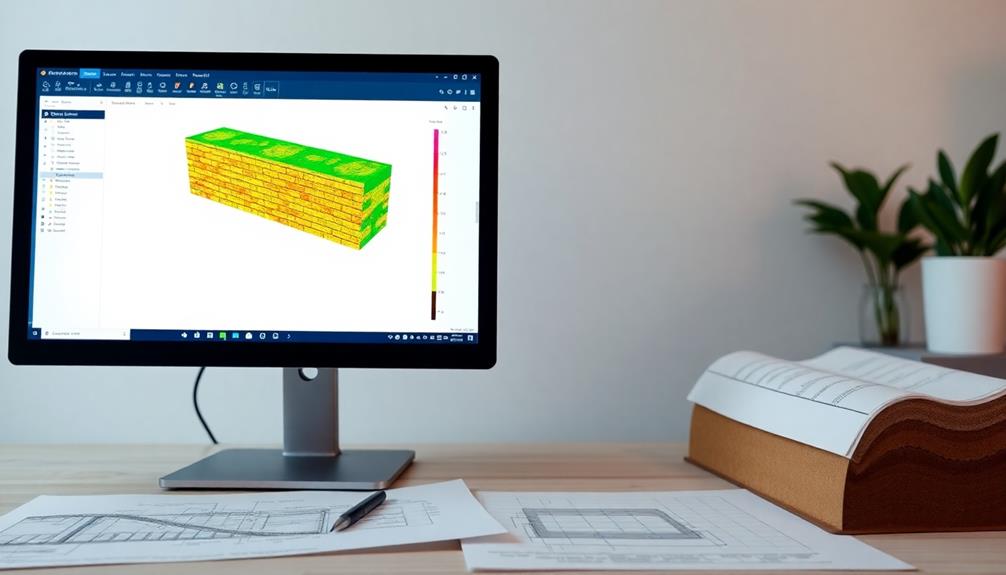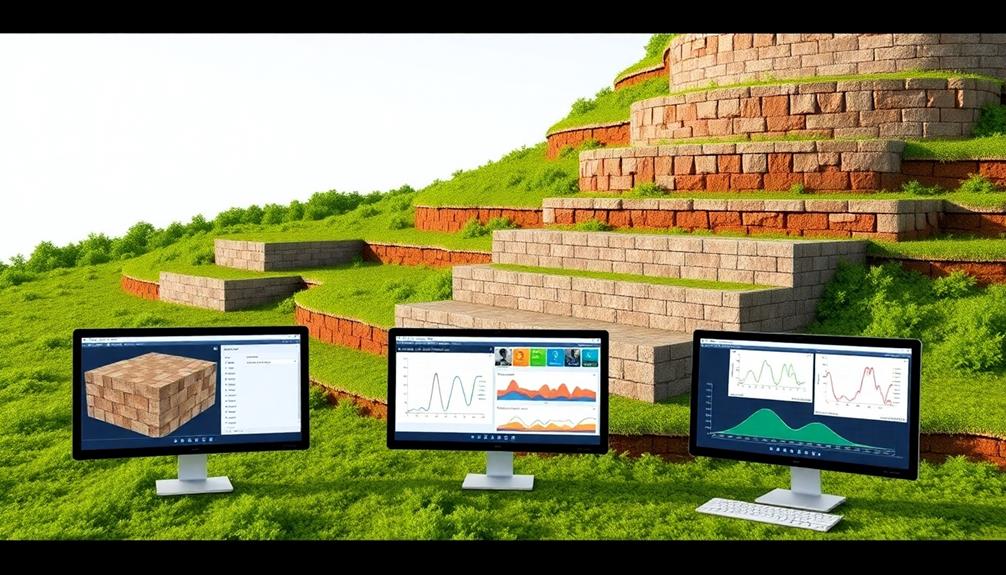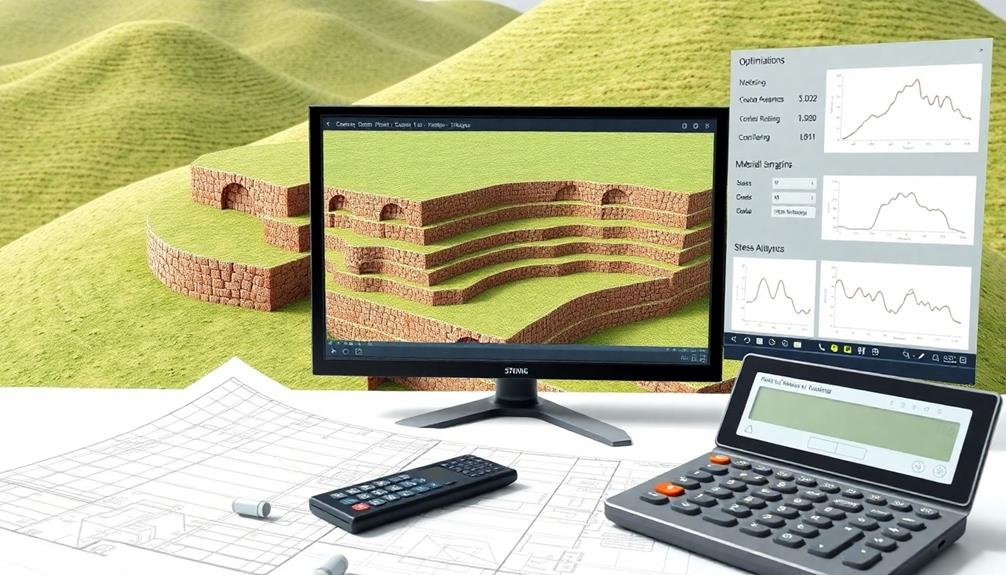Modern retaining wall engineering software provides exhaustive tools for structural analysis, load calculation, and soil-structure interaction simulation. These sophisticated programs offer extensive material libraries, advanced algorithms for complex force modeling, and finite element analysis capabilities. They enable engineers to optimize designs for safety, durability, and cost-effectiveness while considering site-specific parameters and environmental factors. Features such as automated calculations, parametric design tools, and integration with Building Information Modeling (BIM) systems streamline workflows and enhance project visualization. The best software solutions balance accuracy, efficiency, and user-friendliness, empowering engineers to create robust, economical retaining wall designs. Further exploration reveals additional benefits and capabilities of these powerful engineering tools.
Table of Contents
ToggleWalls Contractor Highlights
- Advanced software offers comprehensive load calculation capabilities for analyzing soil pressure, surcharge loads, and hydrostatic forces.
- Material property modeling features enable accurate simulation of long-term wall performance and optimization of designs.
- Sophisticated soil-structure interaction analysis tools utilize finite element methods and advanced constitutive models.
- Time-saving automation features streamline workflows, automate calculations, and enable rapid design iterations.
- Enhanced project visualization capabilities facilitate improved communication among stakeholders and seamless integration with BIM systems.
Structural Analysis Tools for Walls

Structural analysis tools for retaining walls are essential for engineers to accurately assess and design these indispensable structures. Advanced software packages offer sophisticated load calculation capabilities, allowing for the precise determination of earth pressures, surcharge loads, and seismic forces acting on the wall.
These tools also provide thorough material property modeling features and soil-structure interaction analysis, enabling engineers to simulate complex scenarios and optimize wall designs for safety, stability, and cost-effectiveness. Boulder retaining walls offer unique challenges and opportunities in structural analysis, as their natural shapes and sizes require specialized modeling techniques to guarantee proper load distribution and stability. The long-term durability of boulder walls makes accurate structural analysis even more pivotal for confirming their performance over time.
Load Calculation Capabilities
When evaluating retaining wall engineering software, load calculation capabilities are paramount for ensuring structural integrity and safety. The most effective programs offer extensive tools for analyzing various load types, including soil pressure, surcharge loads, and hydrostatic forces. These sophisticated applications employ advanced algorithms to accurately model the complex interplay of forces acting upon retaining structures.
Top-tier software solutions provide engineers with the ability to input site-specific parameters, such as soil properties, groundwater conditions, and seismic factors. This level of customization allows for precise load calculations tailored to each unique project. Additionally, leading programs incorporate both deterministic and probabilistic analysis methods, enabling engineers to assess potential failure modes and optimize designs accordingly.
Advanced retaining wall software often includes features for calculating global stability, sliding resistance, and overturning moments. These capabilities are essential for ensuring that designed structures meet or exceed relevant safety standards and building codes. By automating complex calculations, these tools not only improve accuracy but also greatly reduce the time required for design iterations. This efficiency allows engineering teams to explore multiple design alternatives and ultimately deliver more cost-effective and reliable retaining wall solutions for their clients.
Material Property Modeling
Building upon the foundation of load calculation capabilities, effective retaining wall engineering software must also excel in material property modeling. This critical feature allows engineers to accurately represent the diverse materials used in retaining wall construction, including concrete, steel, soil, and geosynthetics. Advanced software solutions offer extensive libraries of material properties, enabling users to select from pre-defined options or input custom parameters to reflect site-specific conditions.
The most sophisticated programs incorporate complex material models that account for non-linear behavior, time-dependent effects, and environmental factors. These models simulate the real-world performance of materials under various loading conditions, considering aspects such as creep, shrinkage, and thermal expansion. By integrating material property modeling with structural analysis tools, engineers can predict long-term wall performance, assess potential failure modes, and optimize designs for durability and cost-effectiveness.
Furthermore, cutting-edge software packages facilitate sensitivity analyses, allowing users to evaluate the impact of material property variations on overall wall stability. This capability is particularly valuable when dealing with uncertain soil conditions or when exploring alternative material selections to enhance project sustainability and resilience.
Soil-Structure Interaction Analysis
How does advanced retaining wall engineering software tackle the complex interplay between soil and structure? These sophisticated tools employ robust algorithms to simulate the intricate soil-structure interaction, providing engineers with thorough insights into wall behavior under various loading conditions. By integrating finite element analysis (FEA) and geotechnical modeling, the software accurately predicts stress distributions, deformations, and potential failure modes.
Leading retaining wall engineering software incorporates advanced constitutive models to represent soil behavior, accounting for factors such as nonlinearity, anisotropy, and time-dependent responses. These models enable engineers to simulate realistic soil-structure interactions, including phenomena like soil arching and progressive failure. The software also considers the effects of water pressure, seismic loads, and construction sequences on wall performance.
Through iterative analysis, engineers can optimize wall designs by adjusting parameters such as reinforcement layout, drainage systems, and foundation configurations. The software's ability to generate detailed reports and visualizations empowers professionals to make informed decisions and communicate complex concepts to stakeholders. By leveraging these powerful tools, engineers can safeguard the safety, durability, and cost-effectiveness of retaining wall structures while adhering to industry standards and local regulations.
Benefits

Retaining wall engineering software offers numerous benefits that greatly enhance the design and construction process. These advanced tools provide improved design accuracy through sophisticated structural analysis, while time-saving automation features streamline workflow and increase productivity.
Retaining wall materials can be easily compared and evaluated within the software, allowing engineers to select the most suitable options for each project. Additionally, the software's cost reduction capabilities and enhanced project visualization tools enable engineers to optimize designs, minimize material usage, and effectively communicate complex concepts to stakeholders, ultimately leading to more efficient and successful retaining wall projects.
Improved Design Accuracy
One of the most significant benefits of using retaining wall engineering software is the substantial improvement in design accuracy. These sophisticated tools leverage advanced algorithms and mathematical models to analyze complex soil conditions, structural loads, and environmental factors with unprecedented precision. Engineers and designers can input a wide array of variables, including soil composition, groundwater levels, seismic activity, and surcharge loads, to generate highly accurate simulations of wall performance under various scenarios.
The software's ability to perform iterative calculations and optimize design parameters guarantees that retaining walls are not only safe but also cost-effective. By minimizing over-engineering and material waste, these programs help project teams achieve ideal results while adhering to strict safety standards and building codes. Additionally, the integration of Building Information Modeling (BIM) capabilities allows for seamless collaboration between different disciplines, reducing the likelihood of design conflicts and errors. As a result, engineers can confidently present their designs to clients and stakeholders, knowing that the proposed solutions are backed by rigorous analysis and industry-leading technology.
This level of accuracy ultimately translates to increased reliability, longevity, and performance of retaining wall structures in real-world applications.
Time-Saving Automation Features
Engineering software's time-saving automation features revolutionize the retaining wall design process. These advanced tools streamline workflows, allowing engineers to focus on critical design aspects rather than repetitive tasks. By automating calculations, data input, and report generation, software drastically reduces the time required for project completion while minimizing human error.
Modern retaining wall software incorporates intelligent algorithms that automatically adjust design parameters based on site conditions, soil properties, and loading scenarios. This dynamic approach enables engineers to rapidly iterate through multiple design options, optimizing wall performance and cost-effectiveness. Moreover, automated clash detection identifies potential conflicts with existing structures or utilities, preventing costly revisions during construction.
Integration with Building Information Modeling (BIM) platforms enhances collaboration among project stakeholders, facilitating seamless data exchange and version control. Parametric modeling capabilities allow for quick modifications to wall geometry, reinforcement layouts, and material specifications, instantly updating associated calculations and drawings. Additionally, automated quantity takeoffs and cost estimation features provide accurate project budgeting, enabling informed decision-making throughout the design process. These time-saving automation features not only increase productivity but also foster a sense of confidence and efficiency within engineering teams.
Cost Reduction Capabilities
Frequently, the cost reduction capabilities of retaining wall engineering software offer ample benefits to both designers and project stakeholders. These advanced tools streamline the design process, minimizing errors and reducing the need for costly revisions. By automating complex calculations and providing accurate material quantity estimates, the software enables engineers to optimize designs for cost-efficiency without compromising structural integrity.
One of the primary cost-saving features is the ability to perform rapid iterations and compare multiple design scenarios. This allows engineers to explore various materials, dimensions, and construction techniques to identify the most economical solution. Additionally, many software packages integrate with Building Information Modeling (BIM) systems, facilitating collaboration between different disciplines and reducing coordination errors that could lead to expensive on-site modifications.
Furthermore, these tools often include libraries of pre-engineered components and standardized details, which can greatly reduce design time and associated labor costs. By leveraging these resources, engineers can focus on project-specific challenges while maintaining consistency across designs. The software's ability to generate detailed reports and construction documents also minimizes the risk of misinterpretation during the bidding and construction phases, potentially averting costly disputes and delays.
Enhanced Project Visualization
Visualizing complex retaining wall designs becomes markedly easier with advanced engineering software, offering numerous benefits to project stakeholders. These sophisticated tools provide a comprehensive platform for creating detailed 3D models, allowing engineers, architects, and clients to gain a holistic understanding of the proposed structure within its environmental context. By generating lifelike renderings and interactive walkthroughs, the software enables teams to identify potential issues, optimize designs, and make informed decisions long before breaking ground.
The enhanced visualization capabilities facilitate improved communication among team members and clients, fostering a sense of collaboration and shared vision. Stakeholders can explore various design alternatives, material options, and construction methodologies in a virtual environment, leading to more efficient project planning and execution. In addition, these tools often integrate with Building Information Modeling (BIM) systems, enabling seamless data exchange and coordination across disciplines.
The ability to visualize complex geotechnical data, such as soil layers and groundwater conditions, alongside the structural elements of the retaining wall, provides invaluable insights for engineers to refine their designs and ensure peak performance and safety throughout the project lifecycle.
Cost-Effective Design Optimization Techniques

Leading retaining wall engineering software offers cost-effective design maximization techniques that streamline the design process and enhance structural efficiency. These techniques encompass automated material selection, which identifies the most suitable and economical materials based on project requirements and local availability. Moreover, advanced load distribution analysis capabilities enable engineers to precisely calculate and distribute forces, ensuring perfect wall performance while minimizing material usage. Parametric design tools allow for rapid iteration and comparison of multiple design alternatives, facilitating the exploration of various configurations to achieve the most cost-effective solution.
| Optimization Technique | Key Benefits | Software Implementation |
|---|---|---|
| Automated Material Selection | Cost reduction, Time savings | Material databases, AI-driven recommendations |
| Load Distribution Analysis | Structural efficiency, Safety | Finite element analysis, Stress modeling |
| Parametric Design Tools | Design flexibility, Quick iterations | Customizable templates, Visual programming |
| Constructability Assessment | Reduced on-site issues, Faster construction | 3D modeling, Clash detection |
| Life Cycle Cost Analysis | Long-term cost optimization, Sustainability | Maintenance prediction, Environmental impact assessment |
Automated Material Selection
Through automated material selection, retaining wall engineering software can substantially enhance cost-effective design optimization. This advanced feature allows engineers to efficiently evaluate multiple material options simultaneously, considering factors such as strength, durability, availability, and cost.
By leveraging extensive material databases and intelligent algorithms, the software can swiftly identify the most suitable materials for each component of the retaining wall structure, ensuring ideal performance while minimizing expenses.
The automated material selection process typically incorporates real-time pricing data, local availability information, and sustainability metrics. This comprehensive approach enables engineers to make informed decisions that balance economic considerations with environmental impact and long-term performance.
Additionally, the software can analyze various combinations of materials, taking into account their interactions and compatibility, to propose innovative solutions that might not be immediately apparent through manual selection methods. By streamlining this pivotal aspect of retaining wall design, engineers can dedicate more time to refining other essential elements of the project, ultimately resulting in more robust, cost-effective, and sustainable structures that meet the diverse needs of clients and stakeholders in the construction industry.
Load Distribution Analysis
Load distribution analysis forms the cornerstone of cost-effective design optimization techniques in retaining wall engineering software. This sophisticated process enables engineers to meticulously evaluate the distribution of forces acting upon the retaining wall structure, ensuring ideal performance while minimizing material usage and construction costs.
By leveraging advanced algorithms and finite element analysis, these software solutions provide a thorough understanding of how various loads, including soil pressure, hydrostatic forces, and surcharge loads, interact with the wall components.
The analysis typically involves a multi-step approach, beginning with the creation of a detailed model that incorporates site-specific parameters such as soil properties, groundwater conditions, and external loadings. The software then simulates the wall's behavior under different scenarios, allowing engineers to identify potential weak points and optimize the design accordingly.
This iterative process enables the development of tailored solutions that meet project requirements while maximizing efficiency. By fine-tuning factors such as wall thickness, reinforcement placement, and foundation design, engineers can achieve a delicate balance between structural integrity and cost-effectiveness, ultimately delivering retaining wall solutions that are both robust and economically viable.
Parametric Design Tools
Parametric design tools represent a significant advancement in cost-effective design optimization techniques for retaining wall engineering software. These sophisticated tools enable engineers to efficiently explore multiple design variations by automatically adjusting key parameters and generating ideal solutions. By leveraging parametric modeling, professionals can rapidly evaluate various wall configurations, material options, and construction methods to identify the most economical and structurally sound designs.
The integration of parametric design capabilities within retaining wall software empowers engineers to streamline their workflow and enhance decision-making processes. These tools facilitate the simultaneous consideration of multiple design criteria, such as wall height, soil conditions, reinforcement requirements, and material costs. By systematically analyzing numerous design iterations, engineers can identify the most cost-effective solutions that meet project specifications and regulatory requirements.
Additionally, parametric design tools often incorporate advanced optimization algorithms that can automatically generate design alternatives based on user-defined constraints and objectives, considerably reducing the time and effort required for manual design iterations. This approach not only improves design efficiency but also promotes innovation by enabling engineers to explore novel solutions that may not have been apparent through traditional design methods.
Walls Contractor FAQ
How User-Friendly Are These Software Options for Beginners?
The user-friendliness of these software options for beginners varies. While some offer intuitive interfaces and tutorials, others may require more technical knowledge. It's advisable to explore free trials and user reviews to find the most suitable option for your skill level.
Can These Programs Integrate With Other Construction Management Software?
Many retaining wall engineering programs can indeed integrate with popular construction management software, enhancing workflow efficiency. This seamless connectivity allows our team to streamline processes, share data, and collaborate more effectively across various project phases and disciplines.
What Level of Technical Support Is Typically Offered With These Software Packages?
Technical support for these software packages typically includes thorough assistance, ranging from basic troubleshooting to advanced problem-solving. Many providers offer multiple channels of support, including phone, email, and live chat, ensuring users feel supported throughout their experience.
Are There Any Free or Open-Source Alternatives to Commercial Retaining Wall Software?
While commercial options dominate, some free alternatives exist for retaining wall design. Open-source software like RetWall and ReWaRD offer basic functionality. However, these may lack advanced features and support available in paid solutions popular among professionals.
How Often Are These Software Programs Updated With New Features and Regulations?
Software updates for retaining wall programs typically occur annually or bi-annually, incorporating new features and regulatory changes. However, frequency can vary by developer. Users should stay connected with their chosen software community for the latest information and enhancements.







